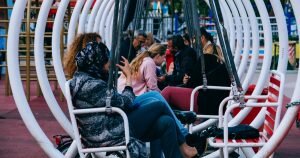 Source: Four Ways to Build Inclusive, Healthy Places for All – RWJF
Source: Four Ways to Build Inclusive, Healthy Places for All – RWJF
It has been said that inspiration comes when you least expect it. My visit to Melbourne, Australia, inspired me to take an international look at place-making. I was standing in Federation Square, restlessly waiting for my daughter to finish her shift. I hadn’t seen her in nearly a year. I was wearing my mom hat, not my urban planner’s hat.Nevertheless, as my eyes swept the Square, I had the sense of being in a very special place. And while I didn’t know it at the time, I was not surprised to later learn that Federation Square in the heart of Melbourne has been recognized as one of the best public squares in the world. Fed Square, built on top of a working railway, comprises sculpted and natural elements; it has small spaces like fire pits; and large and medium-size open spaces for planned and unplanned activity. There is a large TV screen that broadcasts international and national sporting events (it is not always on). The Square is open 24 hours a day; has free Wi-Fi for all; rest rooms; and no signs prohibiting activity or lingering. Restaurants open their doors to it; and transit lines and shops surround it.I visited Fed Square daily for eight days, and what impressed me was how well it reflected Melbourne’s rich cultural diversity; how seamlessly it connected to the streets, buildings and facilities on its periphery; and how welcoming it always felt. It is a place for people—the well-heeled, the not-so lucky—and everyone in between. I should note, though, that Federation Square’s value as an open public space and cultural hub is currently being tested. Controversial changes to it are pushing forward sans public review and participation.
Public spaces like these—parks, playgrounds, town squares, transit stations, streets and more—offer respite, a place to gather, socialize, and be active. They reflect history, culture and potential; strengthen communities and build social capital. However, not all spaces are created equally or equitably. Thinking back to a workshop I facilitated years ago here in the United States, I asked participants to describe a public place where they enjoyed walking or biking. Two students—leaders in a campus sustainability group—shrank when it was their turn, embarrassed to confess that they never had access to such a place.
 Source: Four Ways to Build Inclusive, Healthy Places for All – RWJF
Source: Four Ways to Build Inclusive, Healthy Places for All – RWJF
 Source: Four Ways to Build Inclusive, Healthy Places for All – RWJF
Source: Four Ways to Build Inclusive, Healthy Places for All – RWJF